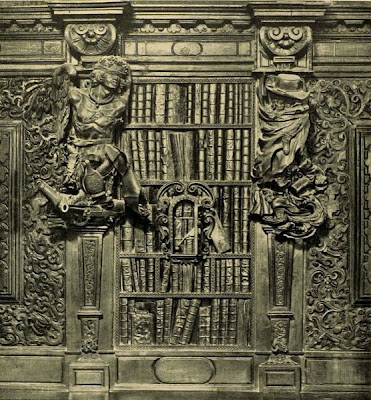| Il Furore |
On the base of his portrait of Tintoretto, Francesco Pianta signed as "FRANCISCUS PIANTA IUNIOR VENETUS" (Francesco Pianta the Younger of Venice). Pianta (1634-1690) belonged to a Venetian family of stonecarvers but the list of books left to his heirs documents a level of culture ununsual for a stoneworker.
Pianta was prominent among a group of sculptors active in Venice who worked exclusively in wood. Their fanciful or bizarre carvings for prominent patrons in Venice can still be seen today. The work for which Francesco Pianta is remembered most is the large series of wooden panels with allegorical secular figures for the large hall of the Scuola Grande di San Rocco, 1657-58.
The Scuola Grande di San Rocco is often referred to as Venice's Sistine Chapel, because of its two floors with more than 50 paintings on the walls and ceilings, but the carved wood sculptures by Francesco Pianta are stunning. At the sides of the extraordinary Library (alone sufficient to demonstrate the artistic stature of Pianta), one prceives the convincing effect of the realistic illusion, which includes "antique bound volumes" flanked by allegorical figures.
Blindfold and chained, Fury presents gnashing teeth and, in the words of Mario Praz, "inspires in his torment a grim dark beauty" (Le bizzarre sculture di Francesco Pianta, [Venezia]: Sodalizio del libro, 1959).
The Spy is almost a caricature, enveloped in his ample cloak and with his hat pulled down and partly covering his eyes.
PIANTA IL GIOVANE FRANCESCO
Lived between 1630 and 1690
Sculptor
He belonged –as Mario Praz affirms– to a generation later than Emanuele Tesauro, the essayist of the recondite wit, and for him too, emblems and hieroglyphics were a real science. His erudite and scientific pretences are proclaimed in the long parchment which Mercury displays beside the entrance door. The parchment is in wood and very closely imitates vellum... While commenting the sculptures of Francesco Pianta in the Sala Superiore of the Scuola di S. Rocco, Mario Praz indicates how scientifically allegorical themes were depicted in Baroque art, and are similar to those in the introduction to the famous Iconologia by Cesare Ripa (first published in Rome in 1593).
Works displayed at San Rocco:
THE SCUOLA GRANDE (Upper Hall)
Wooden Dossals and statues of characters and allegories: Mercury
Melancholy
Honour
Avarice
Ignorance
Science
The Difference between good and evil
Fury
The Libraria
Curiosity
Scandal
Honest pleasures
Cicero defending sculpture
Caricature of Tintoretto, defender of painting
Abundance – Stratagem
Immoral Blame
Female Figures (Caryatids)
Hercules
Pianta was prominent among a group of sculptors active in Venice who worked exclusively in wood. Their fanciful or bizarre carvings for prominent patrons in Venice can still be seen today. The work for which Francesco Pianta is remembered most is the large series of wooden panels with allegorical secular figures for the large hall of the Scuola Grande di San Rocco, 1657-58.
The Scuola Grande di San Rocco is often referred to as Venice's Sistine Chapel, because of its two floors with more than 50 paintings on the walls and ceilings, but the carved wood sculptures by Francesco Pianta are stunning. At the sides of the extraordinary Library (alone sufficient to demonstrate the artistic stature of Pianta), one prceives the convincing effect of the realistic illusion, which includes "antique bound volumes" flanked by allegorical figures.
 |
| Francesco Pianta, The Libreria: Allegories of Fury and Curiosity, wood carved sculptures, 1657-58. Sala Capitolare, Scuola Grande di San Rocco, Venice image source |
Blindfold and chained, Fury presents gnashing teeth and, in the words of Mario Praz, "inspires in his torment a grim dark beauty" (Le bizzarre sculture di Francesco Pianta, [Venezia]: Sodalizio del libro, 1959).
| Fury image source |
The Spy is almost a caricature, enveloped in his ample cloak and with his hat pulled down and partly covering his eyes.
| The Spy image source |
PIANTA IL GIOVANE FRANCESCO
Lived between 1630 and 1690
Sculptor
He belonged –as Mario Praz affirms– to a generation later than Emanuele Tesauro, the essayist of the recondite wit, and for him too, emblems and hieroglyphics were a real science. His erudite and scientific pretences are proclaimed in the long parchment which Mercury displays beside the entrance door. The parchment is in wood and very closely imitates vellum... While commenting the sculptures of Francesco Pianta in the Sala Superiore of the Scuola di S. Rocco, Mario Praz indicates how scientifically allegorical themes were depicted in Baroque art, and are similar to those in the introduction to the famous Iconologia by Cesare Ripa (first published in Rome in 1593).
 |
| Francesco Pianta, The Library with Allegories of Fury and Curiosity, wood carved sculptures, 1657-58. Sala Capitolare, Scuola Grande di San Rocco, Venice |
Works displayed at San Rocco:
THE SCUOLA GRANDE (Upper Hall)
Wooden Dossals and statues of characters and allegories: Mercury
Melancholy
Honour
Avarice
Ignorance
Science
The Difference between good and evil
Fury
The Libraria
Curiosity
Scandal
Honest pleasures
Cicero defending sculpture
Caricature of Tintoretto, defender of painting
Abundance – Stratagem
Immoral Blame
Female Figures (Caryatids)
Hercules
Francesco Pianta alla Scuola grande di San Rocco
The MET Search the Collections





